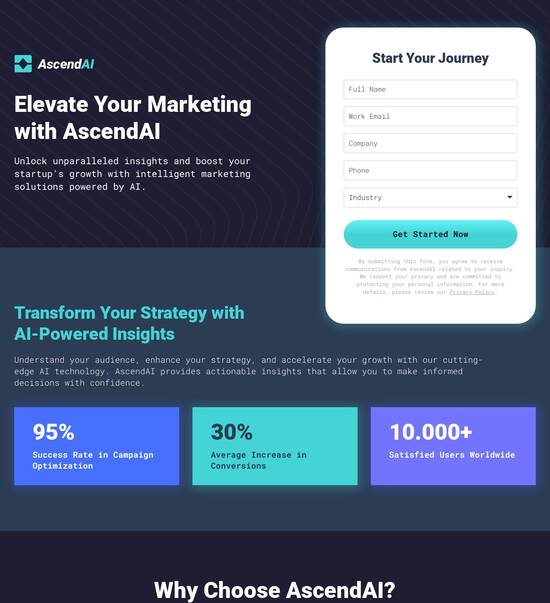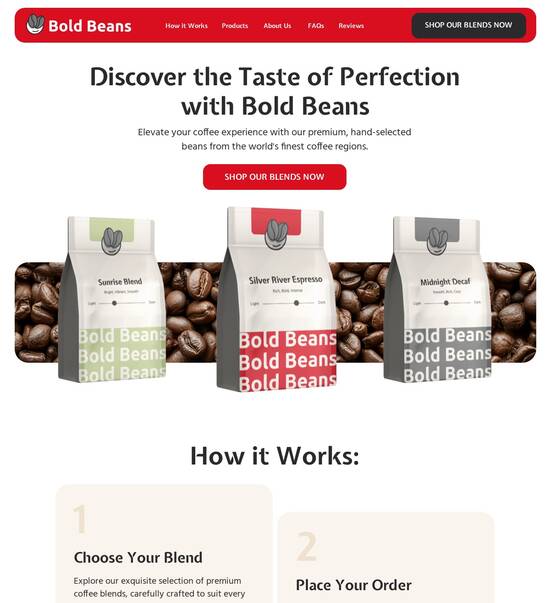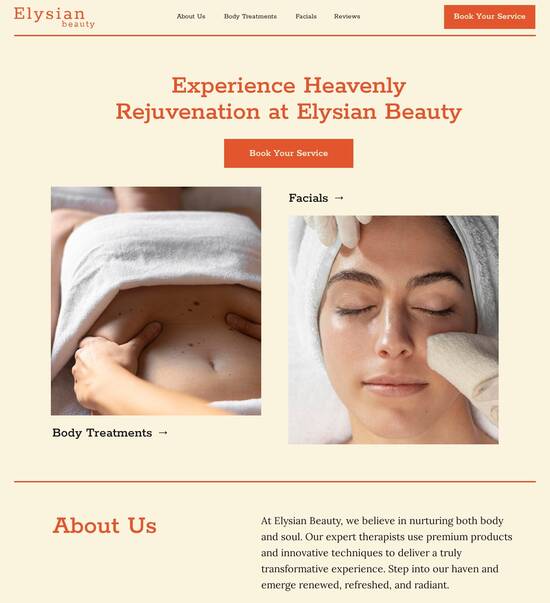
React.js optimized holding page template
Explore Similar TemplatesAbout template
Supercharge your holding page with React.js for outstanding performance! Learn more today.
Recommended templates

Easy to build without coding
With the intuitive drag-and-drop builder, anyone on your team can create high-converting pages without any knowledge of code or design. Make enhancements to your landing page with custom widgets using Javascript, HTML/CSS, or third-party scripts.

Multiple layouts for any industry and goal
Select from 500+ landing page layouts built to boost conversions across industry-specific scenarios. Customize them by adjusting fonts, adding images, and generating on-brand content with the AI assistant. Quickly scale with Instablocks® and Global Blocks that you can save, reuse, and update globally.

Loads fast and looks polished on any device
Every template is responsive, which means they present professionally on any device and load blazingly fast with our Thor Render Engine. You can also power them up with Google AMP technology to deliver an unparalleled mobile experience and drive higher conversions.

Robust analytics & experimentation
Get real-time updates and reporting across all your devices, showing the number of visitors, conversions, cost-per-visitor, and cost-per-lead. Launch AI-powered experiments, run A/B tests, and use heatmaps to analyze user behavior, then optimize your landing page to maximize conversions.







Easy to build without coding
With the intuitive drag-and-drop builder, anyone on your team can create high-converting pages without any knowledge of code or design. Make enhancements to your landing page with custom widgets using Javascript, HTML/CSS, or third-party scripts.
Multiple layouts for any industry and goal
Select from 500+ landing page layouts built to boost conversions across industry-specific scenarios. Customize them by adjusting fonts, adding images, and generating on-brand content with the AI assistant. Quickly scale with Instablocks® and Global Blocks that you can save, reuse, and update globally.
Loads fast and looks polished on any device
Every template is responsive, which means they present professionally on any device and load blazingly fast with our Thor Render Engine.
Robust analytics & experimentation
Get real-time updates and reporting across all your devices, showing the number of visitors, conversions, cost-per-visitor, and cost-per-lead. Launch AI-powered experiments, run A/B tests, and use heatmaps to analyze user behavior, then optimize your landing page to maximize conversions.
All the features you need to build lead-generating landing pages
Explore more featuresLearn how to build top-performing landing pages for any goal
FAQs
Leading the way in building high-performing landing pages





Accelerate Your Marketing with Instapage's Powerful Landing Pages
Instapage's landing page platform is designed to optimize and scale your marketing campaigns effectively. By leveraging the advanced features available, marketers can achieve remarkable ROI while ensuring a seamless user experience. With access to an extensive library of high-converting templates, you can create stunning pages tailored specifically to your audience in the USA.
Step 1: Utilize High-Converting Templates
The first step to designing your ideal landing page is utilizing the array of high-converting templates provided by Instapage. These templates are customizable, allowing you to tailor every aspect to align with your brand's voice and objectives. By choosing a template, you can save time and focus on optimizing your content for conversions.
- Access a library of 100+ ready-to-use templates that are tailored for various industries.
- Customize templates quickly using intuitive drag-and-drop features.
- Incorporate lead generation elements seamlessly into your design.
Step 2: Optimize with Built-in Testing Features
Once your landing page is set up, the next step is to optimize it for maximum conversions using Instapage's built-in A/B testing features. This process allows you to experiment with different page elements to see what resonates best with your audience, increasing the likelihood of conversion.
- Conduct A/B tests on headlines, imagery, and call-to-action buttons to determine top performers.
- Utilize heatmaps to understand how users engage with your content and improve layout accordingly.
- Analyze performance metrics through the detailed analytics dashboard to make informed adjustments.
Step 3: Personalize User Experience
Creating a tailored experience for your audience is crucial in today's digital marketing landscape. Instapage allows you to deliver personalized messages and content based on user behavior and demographics, ensuring that each visit is unique.
- Implement dynamic text replacement to address the user directly.
- Align specific ads with relevant landing pages using AdMaps for enhanced targeting.
- Track audience-level metrics to refine your marketing strategies continuously.
By following these steps, you can significantly enhance the effectiveness of your digital marketing campaigns and maximize conversions.
Now is the time to elevate your landing page strategy with Instapage's powerful tools. Start building pages that not only attract but also convert your target audience effectively.
People also ask about React.js optimized holding page template
Understanding reactjs optimized holding page templates
Understanding the essence of a ReactJS optimized holding page template
Holding page templates are essential tools in the web development landscape, acting as brief but impactful landing pages that inform users about upcoming services, products, or events. These templates serve not only as a placeholder but also as a strategic marketing tool aimed at capturing user interest and building anticipation. The essence of a ReactJS optimized holding page template lies in its ability to combine aesthetic design with functional reliability, ensuring a seamless user experience.
The importance of holding page templates is underscored by their ability to engage users before a full-scale launch. They provide a glimpse into what visitors can expect, which can translate into better retention rates and lead generation as businesses prepare to unveil new offerings. In addition, these pages facilitate the collection of leads through sign-ups and inquiries, laying a foundation for future communications and marketing strategies.
Why choose ReactJS for holding page templates?
ReactJS has gained popularity among developers for creating dynamic and responsive web applications, making it an excellent choice for building holding page templates. Its component-based architecture allows developers to build reusable UI components, significantly enhancing workflow efficiency. Not only does this architecture speed up development times, but it also fosters consistency across the application, leading to a more cohesive user experience.
Another significant advantage of React is its Virtual DOM, which allows for efficient updates and rendering without impacting the overall page performance. This efficiency is crucial in holding page templates where rapid user interactions can occur, ensuring that the interface remains responsive even during periods of high traffic. By leveraging React’s strengths, developers can create highly optimized holding pages that maintain quick load times and reliable performance.
The power of React: Component-based architecture enhances modularity.
Virtual DOM enables efficient updates and minimizes rendering costs.
Enhanced performance leads to a smoother user engagement.
Greater flexibility allows for rapid development and iteration.
Popular use cases for React landing pages often include startups and SaaS applications, where businesses can showcase their services while building an interested audience. Additionally, companies preparing for product launches or seasonal promotions can benefit from holding pages that will create excitement and buzz. By using React, these businesses can ensure their landing pages are not just functional but also visually appealing and informative.
Exploring key features of optimized holding page templates
When considering the design of a ReactJS optimized holding page template, several key features should be prioritized to enhance user experience and boost performance. One of the most critical aspects is fast loading times. Users expect websites to load quickly; delayed load times can lead to increased bounce rates. Implementing strategies such as code-splitting and lazy loading can significantly improve load times, ensuring that vital components are prioritized.
Responsive design is also essential for modern web applications. With various devices being used to access the web, it's crucial that holding pages adapt to different screen sizes and resolutions. By utilizing CSS Flexbox and Grid systems, developers can create fluid layouts that maintain aesthetic integrity across devices. Prioritizing a mobile-first approach ensures that the most crucial information is presented clearly, catering to an increasing number of mobile users.
Fast loading times: Utilize code-splitting and lazy loading to optimize performance.
Responsive design: Ensure compatibility across devices with CSS Flexbox and Grids.
SEO optimization strategies: Implement metadata with React Router for better visibility.
Use server-side rendering (SSR) for enhanced indexing by search engines.
Components of a React landing page template
Creating a compelling React landing page requires understanding the essential UI components that can significantly enhance user interaction. The Navbar is one such essential feature; it facilitates easy navigation across the landing page, ensuring users can quickly access the information they need. A well-structured Navbar can reduce user frustration and create a streamlined flow that encourages users to engage longer with the holding page.
Another critical component is the Hero Section, designed to capture immediate attention. This feature often includes visually striking images or videos and a brief description of what’s being offered. A compelling Hero Section sets the tone and communicates the primary value proposition effectively. Additionally, integrating CTA buttons that are well-positioned and designed with clear messaging drives conversions. Best practices suggest using contrasting colors and actionable language that entice users to click.
Essential UI Components: Navbar enhances navigational ease.
Hero Section composes a compelling introductory display.
CTA Buttons: Employ best practices for effective conversion.
Building interactive features such as sign-up forms is equally vital. These forms should be easy to use while robust enough to collect necessary data. Developers can also enhance these forms by integrating third-party services, which streamlines data collection and allows for immediate user engagement. Moreover, employing state management tools like the Context API or Redux ensures that the application state remains synchronized across the UI, providing a seamless experience for users.
Architecture and design principles
When designing a ReactJS optimized holding page template, understanding layout structure and grid systems is crucial for assembly. Flexbox and CSS Grid provide powerful capabilities for creating responsive designs. Flexbox is useful for one-dimensional layouts, whereas CSS Grid is advantageous for two-dimensional layouts, allowing for more complex arrangements. Leveraging these technologies helps create a visual hierarchy that guides users through the content in a logical manner.
Staying on top of design trends is equally important. Designers often grapple between minimalistic aesthetic approaches and vibrant designs that draw attention. An effective balance can be achieved by utilizing ample white space and contrasting colors that bring focus to key areas. Typography also plays a vital role; choosing fonts that ensure readability while aligning with the overall branding can make or break the effectiveness of a landing page.
Layout Structure: Utilize Flexbox and CSS Grid for responsive designs.
Design Trends: Balance minimalism with vibrant colors.
Typography: Ensure readability and brand alignment.
Deployment and performance optimization techniques
Confidently deploying a ReactJS optimized holding page involves several performance enhancement techniques. Setting up the configuration correctly for optimal builds is essential, especially when using tools like Webpack. Webpack facilitates the bundling of JavaScript files while minimizing bundle sizes through code-splitting, which divides the code into smaller chunks that are loaded on demand. This technological advantage not only results in faster load times but also improves overall user experience.
Moreover, monitoring and tweaking the app’s performance is necessary for maintaining high standards. Developers can utilize the React Profiler tool, which offers insights into rendering performance. By analyzing how components render and identifying potential bottlenecks, developers can make informed decisions on optimizations. Implementing lazy loading for images and components inherently reduces initial loading times and enhances responsiveness, further aiding the user experience.
Configuration for optimal builds: Use Webpack for efficient bundling.
Code-splitting: Increase load times by dividing code into manageable chunks.
Utilize React Profiler to identify performance bottlenecks.
Implement lazy loading for enhanced responsiveness.
Customization and scalability
One of the key advantages of using ReactJS for holding page templates is the ability to customize them extensively. Customizable templates enable businesses to adapt their pages to fit various brand identities, ensuring consistency in messaging and aesthetic alignment. This flexibility is particularly important for marketing campaigns where unique layouts may be needed to resonate with specific audiences. The use of props and state allows for easy adjustments to content without requiring code changes across the entire application.
Scalability is another significant benefit. Well-structured React templates can accommodate growth, whether it's an expanding company needing to add more features or a campaign that requires frequent updates. Future-proofing templates by maintaining clear organization and documentation ensures that developers can efficiently adapt the template without extensive rewrites. This foresight in design promotes longevity and adaptability, making React a fitting choice for any holding page.
Benefits of customizable templates: Align with various brand identities.
Flexibility in layout adjustments for different campaigns.
Growth-ready design: Maintain organization for easy updates.
Real-world examples of ReactJS holding page templates
Numerous brands have effectively launched their software-as-a-service (SaaS) products using ReactJS optimized holding pages. Successful launches often employ strategic design choices that highlight key features and advantages, which resonate with potential users. For instance, a well-placed countdown timer can elicit a sense of urgency and encourage sign-ups before the official product launch. Additionally, prominent testimonials or user reviews foster trust and highlight product credibility.
Analyzing case studies from various industries reveals valuable insights regarding A/B testing and performance metrics. Companies that engage in thoughtful experimentation often see significant improvements in conversion rates. By testing different layouts, CTA placements, and visual elements on their landing pages, organizations can quantify user responses and refine their approaches based on empirical data. This feedback loop aids in optimizing marketing efforts over time, creating a more effective online presence.
Successful SaaS product launches: Highlight effective strategies.
Analysis of design choices and user engagement.
Learning from A/B testing and performance metrics.
Quantifying user responses and conversion rates.
Best practices for implementing React landing page templates
Maintaining the integrity and effectiveness of React landing page templates relies heavily on a structured approach to code review and maintenance. Ensuring clean, maintainable code is essential for scalability and ease of future updates. Proper documentation is equally important; it facilitates easier onboarding for new developers and aids in troubleshooting. Utilizing version control systems like Git provides a safety net, allowing teams to collaborate effectively while tracking changes over time.
User experience should be the focal point throughout the design process. Designing accessible interfaces that cater to users with varying needs increases overall site usability. Gathering user feedback during the testing phase fosters an inclusive development approach, helping to ensure the design meets the expectations and needs of its target audience. This user-centric mindset not only enhances overall satisfaction but also drives engagement and encourages repeat visits.
Code review and maintenance: Ensure clean, maintainable code.
Importance of documentation and version control for effective collaboration.
User experience focused design: Prioritize accessibility in interface design.
Gather and incorporate user feedback during testing.
Future trends in reactjs landing page templates
As technology continues to evolve, the landscape of ReactJS landing page templates is also changing. One of the emerging trends is the increasing role of artificial intelligence in enhancing user interfaces. AI can offer personalized content recommendations based on user behavior, creating tailored experiences that significantly improve engagement rates. Furthermore, the proliferation of headless CMS solutions provides developers the flexibility to manage content across different platforms without compromising on user experience.
Looking ahead, advancements in React itself are likely to influence how templates are built. Enhanced performance features and improved developer tools aim to streamline the development process. Staying ahead of these trends will not only help developers create better land page experiences but will also position businesses as innovators in their respective fields, making it imperative for developers to explore these possibilities.
The role of AI in enhancing user interfaces: Personalizing content.
Emergence of headless CMS for flexible content management.
Anticipated advancements in React for improved features.
Conclusion and reflection
In conclusion, ReactJS optimized holding page templates offer unique benefits that can significantly enhance the user experience and boost marketing efforts. By utilizing a component-based approach, developers can create visually stunning and efficient landing pages that retain user interest and enhance conversion rates. Adapting to best practices and future trends will empower businesses to stay relevant while maximizing their landing page impact.
For developers venturing into this space, the combination of flexibility, performance optimization, and user-centered design will be essential. Embracing innovations and exploring new trends will not only elevate the standard of holding page templates but will also empower marketers to engage their audiences more effectively. When designed thoughtfully, ReactJS landing pages can lay a robust foundation for successful online strategies, making them indispensable in the evolving web development landscape.
Ready to skyrocket conversions?
Supercharge your ad campaigns with high-performing landing pages
Get started














